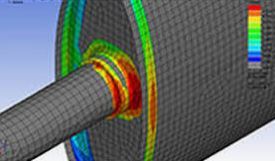
A simple stress analysis is often not enough to predict product life. When components experience complex, time-varying load conditions, relying on static stress results can lead to:
Incorrect critical location predictions
Overdesigned, heavier, and more expensive parts
The solution? In-depth fatigue analysis to estimate product life accurately and cost-effectively.
Fatigue analysis is rapidly becoming standard practice in mechanical design because:
Stress analysis is only the starting point — stress or strain results form the basis for predicting fatigue life.
Fatigue occurs throughout the part — not just at a single peak stress point. Multiple stress hotspots can occur as loads vary over a cycle.
Manual calculations are complex and error-prone — FEA automates the process, evaluating every location in the model.
By using finite element analysis (FEA), engineers gain a complete map of durability performance during the earliest design phases.

Fatigue Doesn’t Only Happen at the Highest Stress Point
Fatigue is not limited to the single point of maximum stress in a component — it can occur anywhere in the part. As loads change throughout a cycle, multiple stress hotspots may appear. In some cases, failure occurs in areas with moderately high, repeated stresses, rather than at the absolute peak stress location.
This is why it’s essential to evaluate stress at every point in the model, not just one location. Manual fatigue calculations are slow, complex, and prone to error. Finite element analysis (FEA) automates the process, providing a complete, accurate fatigue life assessment for the entire component.
We use FEA along with engineering calculations in order to understand the rate at which products and structures fatigue and how to best implement design improvements to economically improve their durability. Using FEA we can locate stresses where cracks are likely to initiate. The same FEA results can then be used to determine how many load cycles it will take for the crack to propagate to failure. All of this durability and safety information is provided while your design is still just on the computer. You will have every opportunity to make adjustments and have the analysis verify the durability improvement.